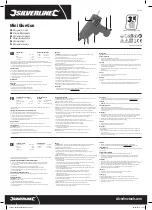
8
9
Installing Fastener Strips
1. Lay the tool on its side and point the
nose of the tool away from yourself and
others.
2. Press the pusher release button and
gently slide back the pusher assembly.
Do not allow the pusher assembly to slide
back fast.
1. Lay the tool on its side and point the
nose of the tool away from yourself and
others.
2. Disconnect the air supply from the tool.
3. Place your hand on the end cap of the
pusher assembly before pressing the
pusher release button. Press the pusher
release button and gently slide back the
pusher assembly. Do not allow the pusher
assembly to slide back fast.
4. Remove fastener strip from the tool.
5. Reload according to "Installing Fastener
Strips".
WARNING
To avoid serious injury, disconnect
the tool from the air supply before
removing fastener strips or clearing
a jammed fastener.
Keep
fi
ngers clear of fastener track
of magazine. Pusher could pinch
fi
ngers, causing injury.
Removing Fastener Strips
Connecting the Air Supply
Use only clean, dry compressed air with a
maximum pressure of 200 psi. Before con-
necting the tool to the air supply, check the
air compressor regulator gauge to be sure it
is functioning properly, with a range between
70-120 psi. Air pressure higher than 120 psi
could cause injury and property damage. The
correct pressure is the lowest pressure that
will do the job.
To connect the air supply:
1. Remove the plastic plug from the tool air
inlet.
2. Insert a 1/4" NPT quick connector into
the tool air inlet.
NOTE:
To improve the seal between
the connector and the tool, and to help
protect against oxidation, apply a PTFE
tape or paste to the connector threads
before insertion.
3. Snap the air hose onto the quick con-
nector.
4. Check for air leakage.
Fig. 2
Pusher
release
button
3. Verify that the magazine is empty and
then connect the air supply to the tool.
Point of
nails in
bottom
groove
Head
of nails
between
the rails
Fig. 3
5. Lay the strip of brad nails
fl
at. The heads
of the nails must fall between the rails
on the back of the magazine.
NOTE:
Use only recommended fasten-
ers of the correct size, length, collation
angle and head type as indicated on the
tool's nameplate.
6. Slide the pusher assembly toward the
nose of the tool until it latches.
WARNING
Always use a coupling that discharg-
es all the compressed air in the tool at
the time the
fi
tting or hose coupling is
disconnected. Using a coupling that
does not discharge the compressed
air could cause unintended operation
and serious injury.
DANGER
Do not use oxygen, combustible gas-
es or bottled gases as a power source
for this tool. The tool will explode and
cause death or serious injury.
WARNING
Always point the tool away from
yourself and others when installing
fasteners. Failure to do so could
result in injury.
Always make sure the tool's maga-
zine is EMPTY before connecting to
the air supply. The tool may actuate
when the tool is
fi
rst connected to the
air supply. Always connect the tool
to the air supply before loading nails
to prevent injury from unintended
actuation.
Never install fasteners with the
workpiece contact or trigger acti-
vated. Failure to do so could result
in injury.
Use only recommended fasteners
of the correct size, length, collation
angle and head type, as indicated
on the tool's nameplate. Refer to the
"Accessories" section for informa-
tion on recommended fasteners.
Other fasteners could result in tool
malfunction, leading to injury.
4. Place the points of a strip of brad nails
onto the bottom groove of the maga-
zine.


























